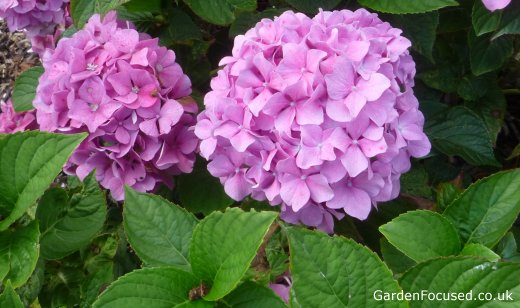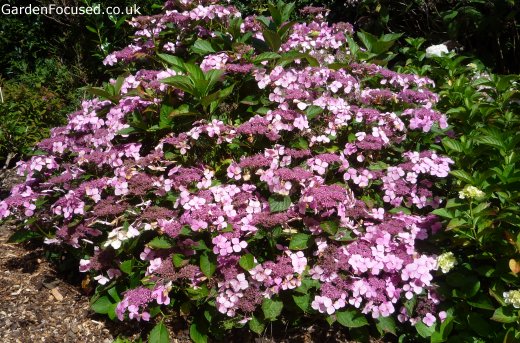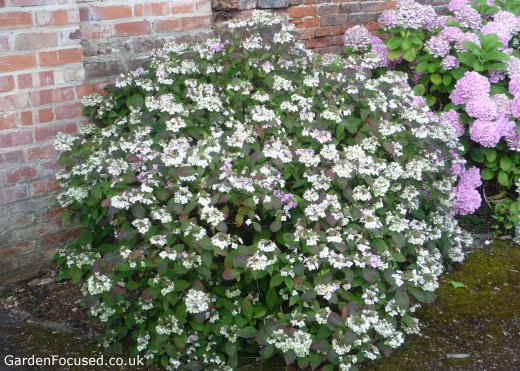GROWING HYDRANGEAS IN THE UK
It’s often thought that the word hydrangea comes from the Greek word for water, principally because these shrubs prefer moist conditions. However “hydrangea” is actually formed from two Greek works “hydor” meaning water and “angos” meaning jar or pitcher.
The part of the flower which looks like a water pitcher, I think (don’t quote me!) is the seed pod.

![]()
Hydrangea macrophylla King George
Hydrangeas can range in size from 90cm / 3ft high to the size of a small tree. However the majority are around the 1.6m / 5 ft height. Flowers are generally large and showy in shades of pink, red, blue and white.
Keep them watered, fed and correctly pruned and you will have a shrub that will grace almost any garden size. For very small gardens, hydrangeas grow well in containers.
KEY FACTS ABOUT HYDRANGEAS
- They grow well in acidic, neutral and alkaline soils.
- They prefer a moist, well-drained soil. They grow well in loam and claysoils
- Prefer a semi-shade position although some varieties can be grown successfully full sun.
- Most hydrangeas flower from August to October, a few varieties startflowering in mid June.
- Hydrangeas in open soil are winter hardy in almost all areas of the UK.
- Several varieties are well suited to growing in containers.
- Skin contact may produce an allergic reaction for some people so gardening gloves may be required.
WHICH HYDRANGEA VARIETY TO SELECT
Hydrangeas Come in a wide variety of colours, sizes and forms, for this reason we dedicated an entire page to help you select the best variety for your circumstances.
WHERE TO BUY HYDRANGEAS
Hydrangeas are popular plants which are widely available from both garden centres and online suppliers. They are also available from many non-specialist suppliers such as supermarkets. Be aware though, buying hydrangeas from supermarkets etc. may well result in the variety not being that named on the label.
Our recommended supplier for Hydrangeas is Crocus who sell a large range of hydrangeas inpot sizes ranging from 2 litres to 12 litres. They offer a five year plant guarantee, top quality plants and excellent service. Click here to see and buy from their extensive range.
WHEN, WHERE AND HOW TO PLANT HYDRANGEAS
WHEN TO PLANT
Although hydrangeas can be planted at any time of year, autumn is the best time, closely followed by early to mid Spring. The reason is that at these times of year the soil will be naturally moist, a key requirement for healthy hydrangeas.
WHERE TO PLANT
A position in semi-shade is ideal for hydrangeas, especially macrophylla and serrata varieties. They prefer morning and late afternoon sun but most will not like being baked in the mid summer, mid day sun.
To minimise the possibility of spring frost damage, plant hydrangeas out of the way of strong winds and not in a frost pocket.
If the position can only be full sun choose paniculata or arborescens varieties (see later down this article for recommended varieties) although these will also thrive in semi-shade.
Hydrangeas vary significantly as far as size is concerned so choose a space large enough for the eventual spread and height of your variety.
Crucial to success with hydrangeas is to plant them in an area where they will have a plentiful supply of moisture. Don’t water log them but moisture is key.
Free draining loam soils are the ideal soil for hydrangeas although they will grow well in clay soil especially if it has been improved by adding wel-rotted organic matter and a mulch is applied on top.
HOW TO PLANT
If you plant hydrangeas at the correct time and in a suitable position, planting them is easy. Simply dig a hole large enough for the root ball so that it sits in the ground at the same level as it was in the container. Infill with some of the removed soil.
Sprinkle on a handful of fish, blood and bone and gently work it in with a trowel. Do not use a nitrogen rich fertiliser, this will only result in excessive leaf growth which can easily be damaged in cold weather. Water the plant in well and cover the surrounding soil with a mulch.
CARING FOR HYDRANGEAS
Hydrangeas are relatively simple to care for, their principal needs are for a constant supply of water and feeding.
WATERING HYDRANGEAS
If a hydrangea runs short of water it will let you know by wilting. However, don’t let it get to this stage because each time they wilt, they loose some of their vigour.
How frequently to water depends on the level of natural rain, the amount of sun, the soil type and the age of the plant. In their first year hydrangeas should be watered each week from early April to mid June, They may require watering twice a week from mid June to mid September. During mid autumn to mid spring only water they should only require watering if there is a shortage of natural rainwater.
In later years, they should only require watering in periods of lower than average rainfall, mainly during summer.
Rain water is naturally acidic to varying degrees so if your hydrangeas are blue, and you want to keep them to that colour, collected rainwater is far better than tap water.

![]()
FEEDING HYDRANGEAS
Feed each hydrangea with a handful or two of fish, blood and bone in mid spring. Do not feed with a high nitrogen feed. On light sandy soils feed again with a handful fish, blood and bone in mid-summer.
MULCHING
Applying a good layer of mulch each spring will achieve two benefits. The mulch will lock moisture into the soil, it also release a low level of nutrients as it rots down each year.
HOW TO PRUNE HYDRANGEAS
Not all types of hydrangea are pruned in the same manner. The key reason for this is that some types of hydrangea flower on stems produced the previous seasons whereas some hydrangeas flower on stems produced in the current season.
If you don’t know the type of hydrangea you will be pruning, click here to go to our variety page for hydrangeas and you will see clear pictures and descriptions to help you identify your hydrangea.
Pruning hydrangeas is not difficult at all but if you get it wrong it is quite possible to prevent it from flowering for a year. For this reason we have written a separate article about pruning hydrangeas and it can be found by clicking here.
COMMON PROBLEMS WITH HYDRANGEAS
Hydrangeas suffer from few pests or diseases.
SLUGS AND SNAILS
Hydrangeas are at their most vulnerable to slug and snail damage when the new growth appears in spring. Some gardens will suffer almost no damage whereas other gardens will suffer damage. There are many articles on how to prevent slugs and snails and we suggest you read those because the subject is extensive.
FROST DAMAGE
Spring frost damage can occur in particularly cold years, however it is very unlikely to kill hydrangeas. The damage will be brown / black leaves and shoots. Wait until the the weather warms up and the hydrangea will start to grow strongly. At this point prune out the damaged areas and the plant will grow well.
PURPLE LEAVES IN SPRING
If a hard frost occurs which does not blacken the foliage, it can sometimes cause the leaves to turn purple. This is a sign that the plant is under stress. There is nothing to be done, when the weather warms up the leaves will turn to their normal green colour without any signs of damage.
HYDRANGEA SCALE
This is an insect pest which lives off the sap of hydrangeas. Because the insects are so small they are almost invisible to the naked eye.
The main symptom you will notice will be small white oval “blobs” on the underside of leaves and in some cases on the stems. These will most likely appear in mid June to mid July. The insects crawl out from this waxy covering and migrate to the stems. The white “blobs” will remain for several weeks although the insects will no longer be under it.
My strong advice would be to examine the undersides of the leaves regularly from mid June to mid July. At the first sign of hydrangea scale, treat the plant immediately and repeatedly (according to the instructions) with your pesticide of choice.
Before spraying, remove as many of the white “blobs” as you can. At this stage you can effectively wipe them away although some will inevitably remain.
We would recommend a natural and organic spray such as Bug Clear for Fruit and Veg Gun or Vitax Plant Guard Pest and Disease Control.
The reason for immediate action is that scale insects are only vulnerable to pesticides when they crawl out from their white covering. Once they then attach themselves to the stems, they form a waxy coating which is impermeable to pesticides.
GROWING HYDRANGEAS IN CONTAINERS
Any hydrangea will grow in a large enough container but some varieties are more suitable than others.Our personal favourite for a container is Hydrangea serrata Bluebird. It grows to a height and spread 1m to 1.2m (3ft to 4ft) in a container. See the picture below.

![]()
Other varieties suitable for growing in containers include
Hydrangea macrophylla ‘Altona’,
Hydrangea macrophylla ‘Little Pink’,
Hydrangea paniculata ‘Skyfall’ and
Hydrangea Runaway Bride Snow White (RHS Chelsea Plant of the Year 2018).
CONTAINER SIZE AND POSITION
A minimum container size for the varieties above would be 40cm / 16in wide and tall. Make sure that the container has adequate drainage holes in the base.
The same rules apply to the position of the container as to planting in open ground. Aim to avoid the hydrangea being in the sun during the middle of the day but sun in the morning and late afternoon is definitely beneficial.
Hydrangeas prefer a position protected from strong winds and this could be even more important for a hydrangea grown in a container. A large container filled with compost and John Innes Number 3 will be a heavy object to move. Ideally you want to avoid the need to move it for overwintering so a protected position is definitely best.
PLANTING A HYDRANGEA IN A CONTAINER
The soil mixture should be similar to one part of peat free multipurpose to two parts John Innes Number 3 compost. The hydrangea should be planted in the new container to the same depth as it was in the previous container.
Leave 5cm / 2in between the top of the compost and top of the new container. This gap can be filled with a mulch such as wood chip, gravel orsimilar to minimise water loss.
CARE OF HYDRANGEAS IN CONTAINERS
Pruning follows allthe rules as described on ourpage about pruning hydrangeas which can be found here.
Feeding is simple. A handful of blood, fish and bone sprinkled over the surface in early spring and at the end of summer isideal. Don’t use a nitrogen rich feed, it will only encourage leaf growth at the expense of flowers. If you want to use a liquid feed instead of blood,fish and bone, use one suitable for tomatoes.
Hydrangeas do best in a moist soil, although not a water logged one. Inthe height of summer they may well need watering daily, less at other timesof the year. Don’t judge the need for water by the surface of the compost.It’s best to stick a finger and inch or so into the compost. If it feels dry, water; if it’s moist, it doesn’t need watering.
HYDRANGEA SUMMARY
Below we list the key strengths and weaknesses of Hydrangeas.
| HARDY | |
| CLAY SOIL | Yes |
| SANDY SOIL | No |
| DRY SOIL | No |
| SHADE | Normally partial shade but depends on variety |
| EVERGREEN | No |
| EASY CARE | |
| SMALL GARDENS | Yes |
| POT / CONTAINER | Yes |
| FLOWERING | |
| FLOWER TIME | mid July to early October |
Other shrubs in this series include Ceanothus,
Choisya, Hebe, Skimmia, Magnolia, Mahonia, Mock Orange, Lilacs, Potentilla and
Rose of Sharon (hibiscus syriacus). Our main shrub index page can be seen by clicking on the link below.